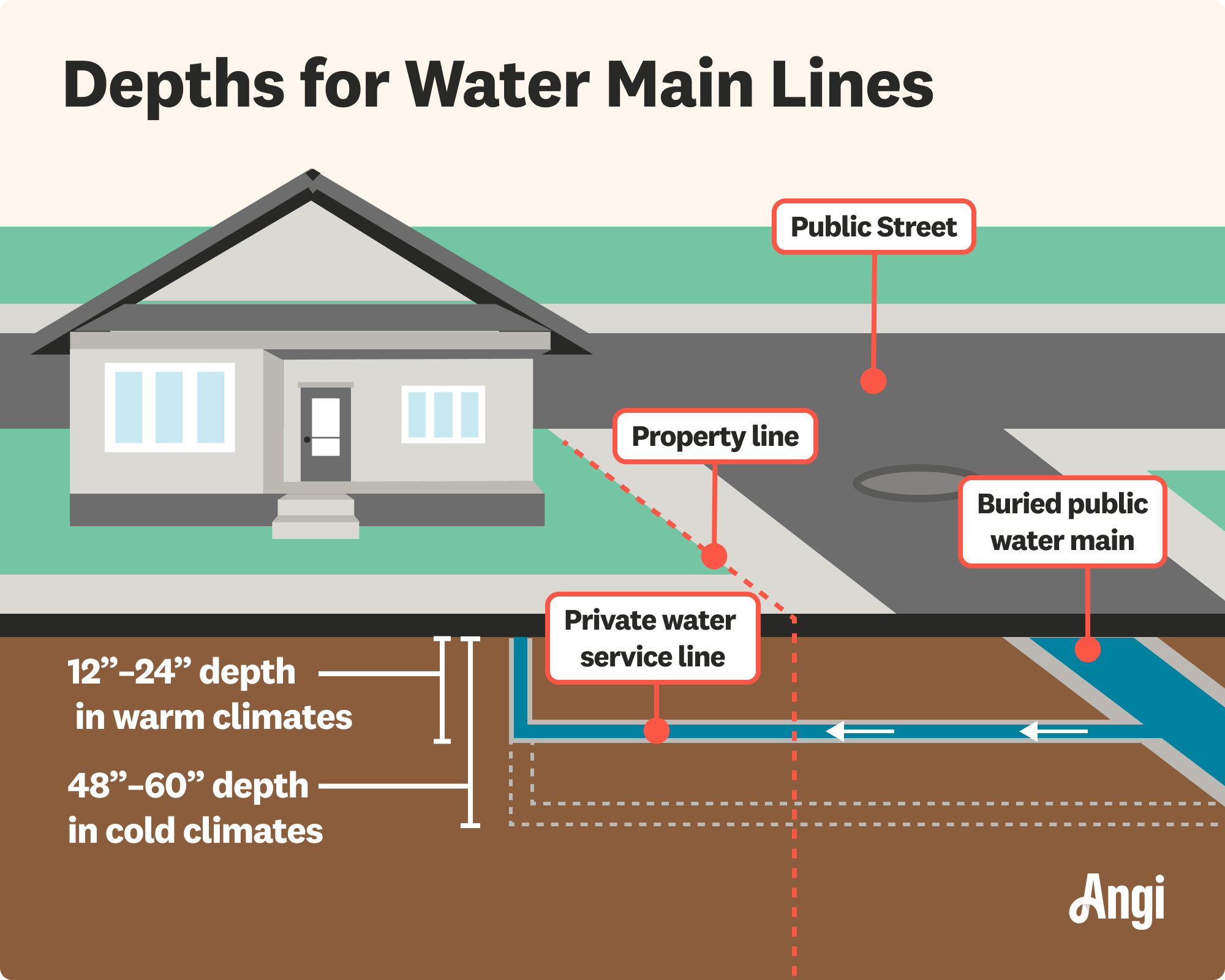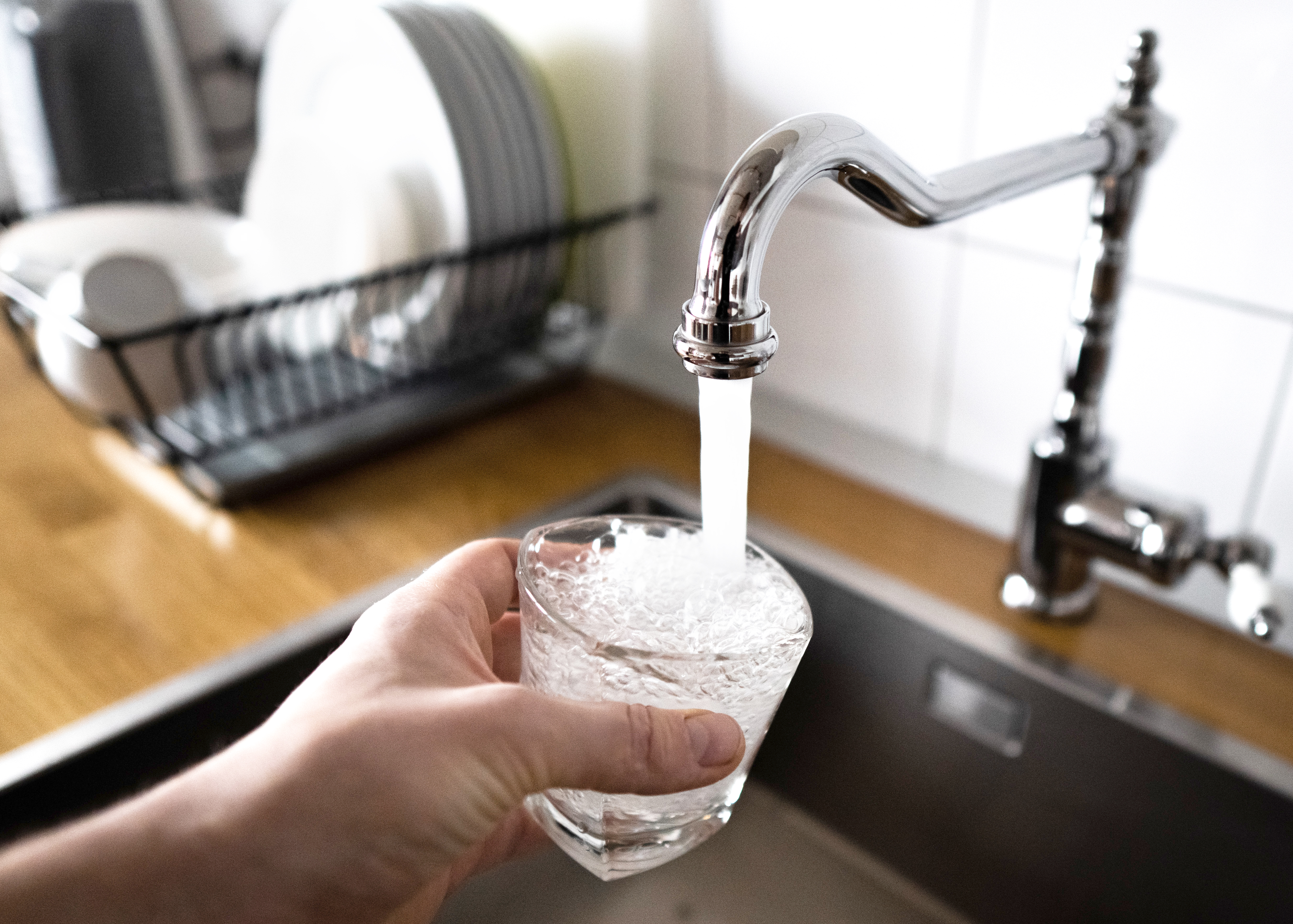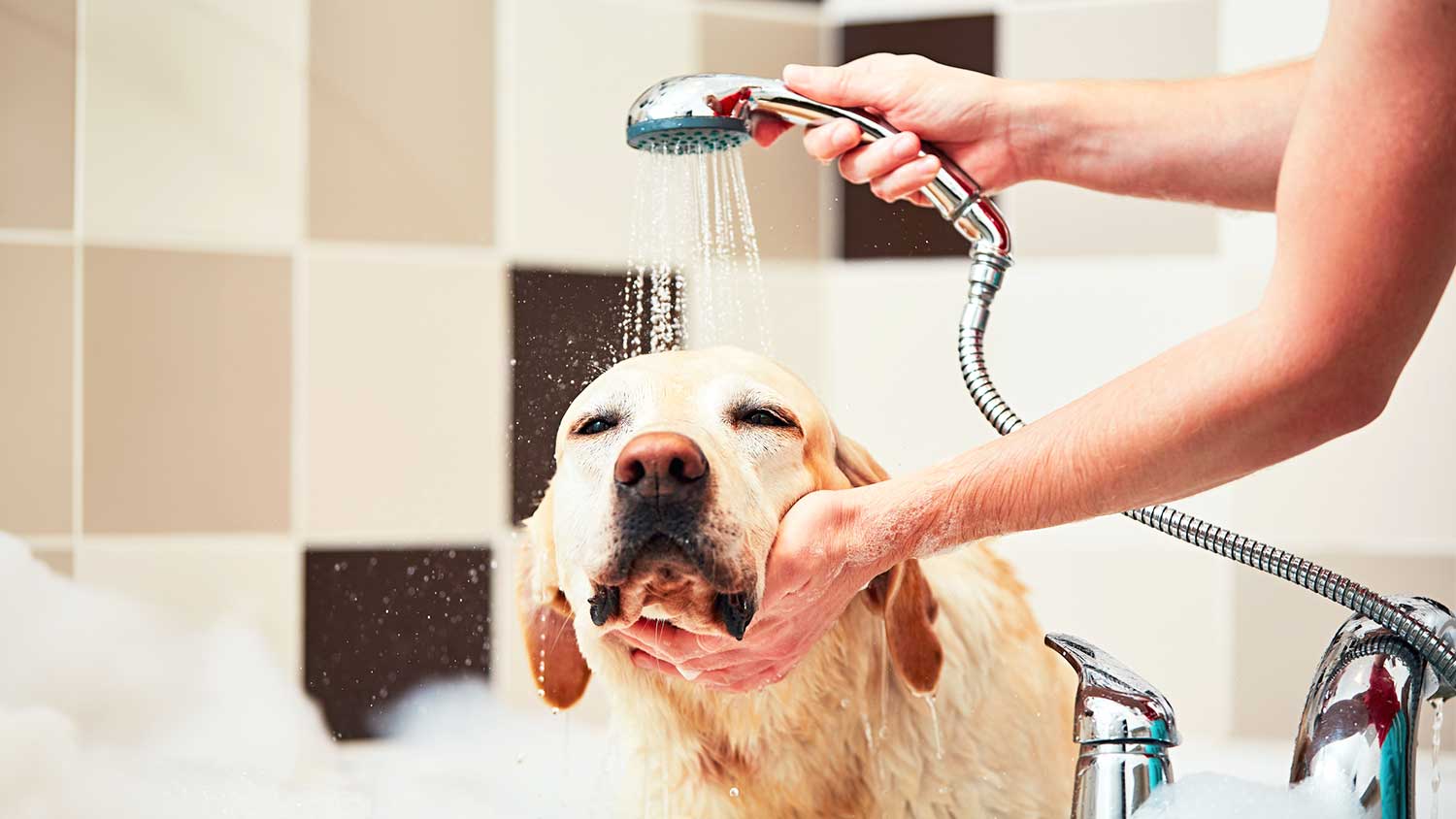
Learn how much plumbers cost in Columbus, Ohio. Discover pricing for faucet repairs, pipe work, and emergency services, plus how you can save money.
Main water line replacement costs an average of $1,711 but ranges from $647 to $2,828, depending on the length and depth of the line, materials, and method. A plumber can assess your project.


Your current main water line's material has a large impact on the replacement cost per linear foot.
Digging a trench for the water main replacement costs significantly more than a trenchless replacement.
Assume that labor prices account for 35% to 60% of the total replacement price.
Where you live and the geography of your landscape affect the difficulty—and thus the cost—of accessing your main water line.
Main water line replacement costs an average of $1,711 or $50 to $150 per linear foot. This section of piping is crucial to your home’s plumbing system. When it’s not functioning properly, you can experience a severe drop in water pressure—not to mention skyrocketing water bills. Depending on the location and nature of the project, prices range anywhere between $200 and $5,000.
Installing a water main costs an average of $50 to $150 per linear foot. Prices may reach as high as $250 per linear foot in areas with high cost of living and for lines that are difficult to access. Labor costs make up the majority of your project costs, especially for systems that need extensive work or are difficult to reach.
It can be hard to find a good plumber, but I found one! I've hired Nick with Plumb Poppin twice and was extremely pleased with both jobs he completed for me. One of the jobs required busting through our slab to replace pipes that had gone bad. He took the time to explain what he had to do to fix the problem, and patiently answered my questions. It was a messy job and he cleaned the areas afterward so well you couldn't even tell the work had been done. He also installed a water filtration system for me. He was on time, has an excellent attitude, is very knowledgeable and quick thinking if a problem pops up. (I live in an older house.) His prices are more than reasonable and he backs up his work! I wouldn't hesitate to hire him, and will be using his services for any future issues I have.
You have two installation options when it comes to replacing your water line: the modern trenchless method and the old-school, trench-based method.
| Replacement Method | Average Cost |
|---|---|
| Trenchless | $75–$150 |
| Trenched | $1,500–$13,000 |
A trenchless water line replacement costs $75 to $150 per linear foot. The process involves boring a hole at each end of the water line and tunneling a cable between these holes. Once the tunnel is complete, your water line professional will snake through a pipe to finish the job. The process does not impact the aesthetics of your yard, which is why it’s a commonly used option. Everything happens underground, aside from two small holes.
Digging and backfilling a trench is a more labor-intensive process, costing $1,500 to $13,000 for this traditional replacement method. These costs do not include replanting grass, repairing sidewalks, and restoring your yard to its former glory, as this method places a toll on your landscaping. The process starts with an excavation machine to find the old line and digging a large trench across the property to uncover it.
Finally, contractors manually remove and replace the line and backfill the trench. In nearly every case, contractors try the trenchless method first, but this aggressive procedure is warranted if inaccessible areas block the water line.

A primary material cost to consider is the pipes that comprise the water line. Many materials are available, each boasting its own cost range, pros, and cons.
PVC: PVC pipes cost $0.50–$5 per linear foot and are the most common type of pipe used for water lines and the go-to for new construction. Though they have a long lifespan and require little maintenance, they can crack with temperature changes and are susceptible to damage from chemicals and root systems.
PEX pipes: Crosslinked polyethylene piping, known as PEX, is flexible, making it easy to install and resistant to freezing and bursting. These pipes are highly durable and affordable, at $0.40–$2 per linear foot.
Cast iron: Cast iron used to be the old standard for water line pipes because it’s not impacted by heat, cold, or soil type. However, it does corrode and rust over time. The weight of this material makes it more difficult and costly to install. Expect to spend $2–$10 per linear foot on these pipes.
Copper: Copper pipes average $2–$10 per linear foot. Overall, they have excellent durability and can last up to 100 years, but they’re susceptible to corrosion, particularly in areas with hard water. Copper pipes can freeze but not until 20 degrees Fahrenheit, making them popular in areas with extremely cold weather.
Fiberglass-reinforced plastic: Fiberglass-reinforced plastic (FRP) piping costs $5–$10 per linear foot and consists of glass fibers surrounding a plastic matrix. It’s a great choice for main water line replacement because it’s corrosion resistant, even in the face of acidic or alkaline materials, untreated sewage, and chemical wastewater. However, it does not tolerate extended exposure to high temperatures.
Hiring a plumber and the labor for this job make up an average of 35% to 40% of your total cost. However, that number will be closer to 60% for trenchless projects because they require specialized equipment and skill sets, although they take less labor time.
The cost of replacing a main water line from the meter to your house will depend on the extent of the work. You may need to hire additional contractors beyond a qualified plumber. This is especially true if the pipe bursts and damages your home’s foundation, roots are impacting the integrity of your piping, or you have a trenched line and removal will disrupt your landscaping and hardscaping. Additional pros you might need to hire include:
Landscaper: $50–$100 per hour
Driveway contractor: $50–$150 per hour
Foundation repair contractor: $150–$250 per hour
Tree removal service: $200–$2,000 per tree
When it comes to the water main’s location on your property, the cost is determined by the amount of piping required. Smaller properties will have drastically reduced project prices compared to properties with more acreage and square footage.
As for geography, areas with severe winters cost slightly more to install a water main line, as the pipes need to go under the frost line, which is often 3 feet or below. This price difference is negligible in the case of a trenchless design, though it adds a few hours of labor when digging a trench to expose the line. According to Angi data, it’s most affordable to replace a main water line in Southeastern states, such as Georgia, South Carolina, and Florida.
Labor and materials make up the lion’s share of your expenses here, but some additional cost factors are worth considering.
| Added Factor | Average Cost |
|---|---|
| Connect city water | $1,500–$13,000 |
| Inspection | $100–$500 |
| Landscaping | $3,500 |
| Replace shut-off | $300–$1,000 |
Rocks and root systems are the main obstructions that slow down this type of project. Roots spread quickly, as they are attracted to the water. You don’t want to dig through the roots, as they are likely attached to trees on your property. Rather, pros dig around roots and rocks to reach the water main, driving up the project cost.
Fortunately, this is only an issue when digging a legitimate trench that runs the length of the pipe, as trenchless designs are not bothered by these types of obstructions unless they are directly adjacent to the water main or entrance to the home’s plumbing.

A water main is buried anywhere from 1 to 3 feet deep, though they go deeper in areas of extreme cold to get below the frost line to prevent freezing. The deeper you go, the higher your costs because of the increased labor time.
In the case of a trenchless design, the added work is negligible, as only two small holes are being dug at either end. However, digging a trench to expose the water line is labor-intensive and the increased depth adds anywhere from 2 to 10 hours to the project. Additionally, this part of the process often necessitates specialized equipment, further driving up the cost.
Before connecting to the city’s main water line, you’ll need an inspection, which costs between $150 and $500. Certain companies offer this service for free to ensure your water lines meet all code requirements.
You’ll most likely need a permit for a main water line replacement, which can go for $100 to $500. Your contractor will most likely take care of the permit process for you, or you can contact your local building code enforcement agency directly.
The main water line is considered a branch line running from the edge of your property to the water meter at your house. In other words, this line still requires a further connection to access the city or municipal water supply. Running a water line from the edge of your property to the city water pipes costs anywhere from $1,500 to $12,000, depending on the materials and distance required.
The harder it is for your plumber to reach the pipe, the higher your costs. Pros will have to work around trees, stones, and landscaping fixtures if a trenchless installation is not possible. This not only increases the labor costs, as digging through or around these areas takes time, but adds a landscaping restoration project. Most plumbers are not qualified to adequately restore landscaping materials, so contact a local landscaper for the best results. The average landscaping project costs around $3,700.
If your main water shut-off valve is damaged, replacing it along with the water main pipes is a way to save on additional service calls down the line. This valve is located where the water enters your home and, when disabled, shuts off all water entering the property.
Replacing a main water shut-off valve costs $400 to $800 or more, depending on factors like age, accessibility, and the materials comprising the valve and related pipes. Also, the valve’s size must change if you upgrade the size of your pipes, increasing the total project cost.
When replacing your home’s main water line, your main choices are trenched and trenchless replacements. Trenchless options are more favored, as these won’t call for digging up your yard, though they’ll cost more in many cases.
| Type of Main Water Line Replacement | Average Cost |
|---|---|
| Trenched | $50–$250 per linear foot |
| Pipe lining (trenchless) | $75–$150 per linear foot |
| Pipe bursting (trenchless) | $50–$200 per linear foot |
| Private main | Up to $2,500 |
Water main line replacement using the trench method goes for around $50 to $250 per linear foot. Digging out and disposing of old lines will drive up this cost.
Trenchless water line replacement using pipe lining costs $75 to $150 per linear foot. This method creates a “new” pipe by pushing an epoxy lining through the old one to fill in any cracks.
The pipe bursting method of trenchless water line replacement costs $50 to $200 per linear foot. This involves using an auger to drill out the old pipe and “bursting” it while dragging in a new replacement pipe.
Replacing your private main water line costs up to $2,500. This line runs from the street to your home. For this project, you’ll need to determine whether you or the city is responsible for the portion that goes beyond your property line to the city’s water supply.
On average, water main replacement costs nearly twice as much as water main repairs. It may be more economical to make repairs when it’s a smaller fix—like fixing a leaky valve or replacing a small section of cracked or corroded piping. That said, you may want to replace your entire line if a significant portion is damaged or it’s nearing the end of its lifespan.
Most water main lines last around 50 years, and homeowners with trenched lines try to minimize work to avoid repeatedly digging up their landscaping and hardscaping. Once repairs become more frequent or amount to more than 50% of the cost of replacement, it’s worth it to replace the line.
Additionally, certain jurisdictions put restrictions on water main repairs involving lead or galvanized piping. If your area has these restrictions, you’ll need to replace the pipe regardless of its condition.
According to data from Angi customers, about 34% of main water line projects involve repairing an existing line. On the other hand, only 15% of customers request a full main water line replacement. Check out the most commonly requested projects:
Since most main water lines last around 50 years, you can guess when you’ll need to replace your line based on the age of your home or when the line was last replaced. However, there are also clear signs to look for that it’s time to replace the main water line:
Discolored tap water (yellow, orange, or brown)
Low water pressure
Sulfur taste in drinking water
Foul-smelling tap water
Puddles around your home’s foundation
Flooding in your yard
Unusually lush, green spots on your front lawn
Gurgling, burping, or banging noises in your home plumbing
High water bill
Visible pipe damage
Labor costs for a main water line replacement can account for 35% to 60% of the total project cost. Hiring a local plumber ensures that complex tasks like digging large trenches, repairing pipes, and navigating tree roots are done safely and last longer.
Plumbing professionals have the knowledge and experience needed to take on this difficult home improvement task. Here’s why you should hire a plumber:
Plumbers can recommend the best water line material for your home and budget, as well as the optimal location for the line.
They understand permitting and depth requirements to follow standards.
Your plumber will likely obtain any necessary permits.
DIY mistakes can lead to water leaks and damage your yard or home.
Plumbers will have the specialized equipment to complete the trenched or trenchless process.
Pros can also replace the main water shut-off valve if it’s old or damaged.
Discuss the water line replacement process and whether your plumber recommends the trenched or trenchless method.
Ask if there is anything you can do to prepare your home or yard for this project.
Be prepared to decide which materials you want to use with input from your plumber.
Home is the most important place on earth, which is why Angi has helped more than 150 million homeowners transform their houses into homes they adore. To help homeowners with their next project, Angi provides readers with the most accurate cost data and upholds strict editorial standards. We’ve surveyed thousands of real Angi customers about their project costs to develop the pricing data you see, so you can make the best decisions for you and your home. We pair this data with research from reputable sources, including the U.S. Bureau of Labor Statistics, academic journals, market studies, and interviews with industry experts—all to ensure our prices reflect real-world projects.
Want to help us improve our cost data? Send us a recent project quote to [email protected]. Quotes and personal information will not be shared publicly.
From average costs to expert advice, get all the answers you need to get your job done.

Learn how much plumbers cost in Columbus, Ohio. Discover pricing for faucet repairs, pipe work, and emergency services, plus how you can save money.

Learn about main water line repair costs in Columbus and what affects pricing to be prepared before you start getting estimates.

Wondering how much it costs to reroute plumbing? We have the information you need to learn about plumbing vent pipes and cost considerations when installing them.

Copper is prone to leaks from corrosion, particularly pinhole leaks. This guide will show you how to fix a copper pipe leak in seven different ways.

Shower diverters will wear down over time and eventually need repairs. This guide will show you how to fix a shower diverter and get your shower working again.

Discover grey water system cost details to learn about installation, maintenance, and ways to save on your home’s grey water system.